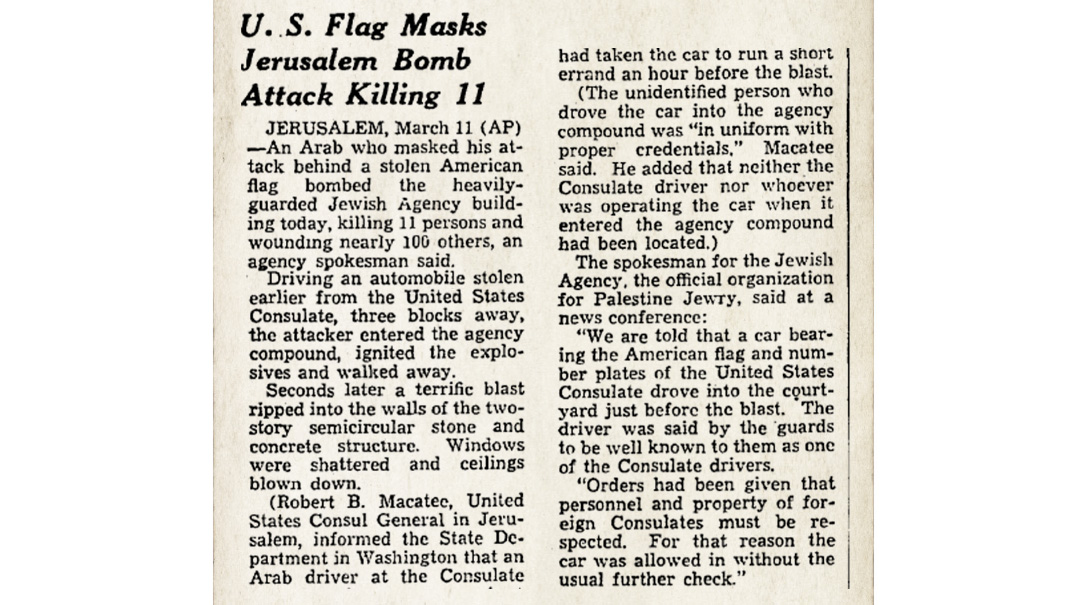The “Volozhin Victims” of the 1948 Keren Hayesod Bombing
| October 25, 2022Dauod rolled unmolested into the Agency courtyard and parked his car directly in front of the Haganah headquarters

Title: The “Volozhin Victims” of the 1948 Keren Hayesod Bombing
Location: Jerusalem
Document: The Boston Globe
Time: March 1948
The burgeoning Yishuv of the early 20th century developed institutions to centralize its activities and establish forms of governance that would serve as infrastructure for a state in the making. These included the offices of the World Zionist Organization, the Jewish Agency, Keren Kayemet, and Keren Hayesod. An impressive structure to house the offices of the various organizations was built in Rechavia on the corner of King George V and Keren Kayemet streets, and completed between 1930 and 1935.
On the morning of March 11, 1948, a Christian Arab named Anton Daoud who was employed as a driver by the nearby US consulate drove his Ford toward the compound.
A platoon of the Haganah stood a discreet but constant guard on the building. Yet now a timid Christian Arab from Bethlehem was about to drive a quarter of a ton of TNT into the heart of the Agency’s compound under the approving eyes of those Haganah guards. … He was so familiar a figure that the building’s Haganah guards had suggested he sell them arms.…
Dauod rolled unmolested into the Agency courtyard and parked his car directly in front of the Haganah headquarters. —O Jerusalem
The ensuing explosion ripped through the Keren Hayesod wing of the building and claimed 14 victims, with an additional 44 injured. This was the culmination of three major attacks masterminded by the Nazi-SS-trained Fawzi el Kutub. The previous two in February had struck the Palestine Post building and Rechov Ben Yehuda, the latter having claimed 59 lives. As the British Mandate wound to an end, the streets of Jerusalem had turned into a veritable bloodbath.
Unbeknownst to the rescue personnel feverishly tending to the injured, two of the deceased lying under the smoldering debris stemmed from the aristocracy of the Torah world — the Volozhin Yeshivah.
Aryeh Leib Yaffe was born in Grodno into a prestigious rabbinical family. A descendant of Rav Mordechai Yaffe, the 16th-century author of the Levush, his grandfather was the longtime rabbi of Ruzhany, Rav Mordechai Gimpel Yaffe. At the age of 14, Aryeh Leib attended the Volozhin Yeshivah and remained until its closing two years later.
He later attended university in Germany and honed his literary skills as both a journalist and a poet. Taking up the cause of the nascent Zionist movement, he served as a delegate to the first Zionist Congress in Basel, and nearly every subsequent congress as well. For many years he served as a charismatic speaker and fundraiser for the Zionist cause. In 1920 he immigrated to Palestine. Following a brief stint as the editor of the Ha’aretz newspaper, he was appointed director of the Keren Hayesod, which served as the fundraising arm of the Yishuv’s institutions. It was in this capacity that he was in his office on that fateful morning.
Another victim was Keren Hayesod employee Michal Raami. Born in 1904 in Mogilev (today in Belarus), her father was Yaakov Berlin, a son of the Netziv of Volozhin from his second marriage. Though Yaakov was a young man when his father passed away, he emerged as a Talmudic scholar and was often the unofficial address in Mogilev for halachic queries. He hosted rabbinical dignitaries who came to town, and Michal’s sister Tova recalled Rav Chaim Brisker spending time in their home. Michal immigrated to Eretz Yisrael in 1924.
The Farmer’s Rabbi
Rav Mordechai Gimpel Yaffe (1820–1891) was an early supporter of Chovevei Zion, and immigrated to Eretz Yisrael in 1888. He settled in Ekron (Mazkeret Batya), the first agricultural settlement established by Baron Edmond Rothschild during the First Aliyah. The yeshivah he founded in Yehud was named Eitz Chaim for his alma mater in Volozhin. During the shemittah year of 1889, he supported the farmers of Ekron in their efforts to observe shemittah in the ideal fashion despite threats from the Baron’s administrators. Prior to his passing in 1891, Rav Yaffe asked to be buried in Petach Tikva’s Segula cemetery, because “the Holy Land isn’t limited to Yerushalayim.”
Last Voyage to Volozhin
Reb Yaakov Berlin struggled to make a living, and in 1921 planned to go to America where his brother Rabbi Meir Berlin then resided. On his way, he stopped in Volozhin to daven at kivrei avos, but contracted an infection, passing away a short time later at the age of 46. A few months ago, Simcha Schecter, a close friend and regular contributor to this column, discovered Reb Yaakov Berlin’s long-obscured kever (just steps from that of Rav Chaim Volozhiner) while exploring the mostly destroyed cemetery in Volozhin.
(Originally featured in Mishpacha, Issue 933)
Oops! We could not locate your form.






